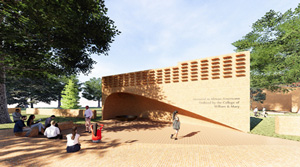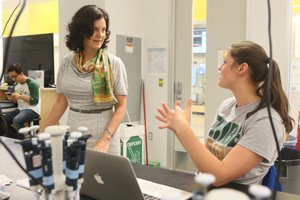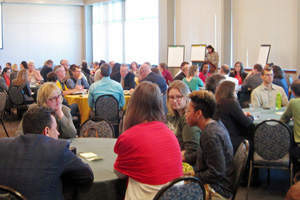A Game Plan for Strategic Planning
On Thursday, April 25, 2019, the William & Mary Board of Visitors dedicated the sundial area in front of Swem as the “Mary-Cooke Branch Munford Plaza.” Mary Munford was the first woman appointed to the Board of Visitors and an advocate for coeducation in the Commonwealth. She was a key force behind William & Mary’s decision to admit women students in 1918. As Professor Jayne Barnard noted at the dedication ceremony, this impressive activist was described by a contemporary as “levelheaded” and “fearless.”
Levelheaded and fearless is the mindset I invite us to embrace as a community, as we launch strategic planning in the fall. Measured decision-making and bold risk-taking is the approach of successful researchers, entrepreneurs and championship athletes. What follows reflects on the year of preparation so far – how we have positioned ourselves for strategic planning – and then outlines overarching goals for the planning process.
The W&M Playbook for Strategic Planning
1. A Culture of Creativity and Collaboration
One of my earliest discoveries at W&M has been our community’s commitment to a fuller understanding of history as a springboard for the future. Last week’s announcement of the winning concept sketch for a Memorial to African Americans Enslaved at William & Mary illustrates the creativity with which we embrace that work.
 The idea for the memorial emerged from the decade-long work of the Lemon Project. In 2009, the Board of Visitors established the Lemon Project to bring the university community together to engage with our history of slavery with humility and dedication. I am deeply grateful to the jury appointed by President Reveley, to the 80-plus anonymous members of the community who submitted concepts, to all the former rectors of W&M who have committed initial funding and to the Board of Visitors who committed matching funds for the memorial. The winning concept sketch was created by William Sendor ’11, an architectural designer, who was inspired by research by Jennifer Oast Ph.D. ’09. “Hearth” seeks to restore the humanity of the enslaved workers who built William & Mary. Activating a part of the campus that has been fallow, it creates a space for reflection on their lives and work. In doing so, the design invites us to challenge and learn from the actions of our past so as to move forward as an inclusive and welcoming community.
The idea for the memorial emerged from the decade-long work of the Lemon Project. In 2009, the Board of Visitors established the Lemon Project to bring the university community together to engage with our history of slavery with humility and dedication. I am deeply grateful to the jury appointed by President Reveley, to the 80-plus anonymous members of the community who submitted concepts, to all the former rectors of W&M who have committed initial funding and to the Board of Visitors who committed matching funds for the memorial. The winning concept sketch was created by William Sendor ’11, an architectural designer, who was inspired by research by Jennifer Oast Ph.D. ’09. “Hearth” seeks to restore the humanity of the enslaved workers who built William & Mary. Activating a part of the campus that has been fallow, it creates a space for reflection on their lives and work. In doing so, the design invites us to challenge and learn from the actions of our past so as to move forward as an inclusive and welcoming community.
2. Committing to the Long Game
Since its founding as the second oldest institution of higher education in the nation, “for all times coming,” William & Mary has played the long game. The FY20 budget, which the General Assembly has now approved, reflects an investment in higher education as a means of recruiting and retaining exceptional talent to the Commonwealth for years to come. The generous budget has enabled William & Mary to take strategic actions on in-state tuition, employee compensation and new degree programs.
- In-state tuition: Generous state investment allowed for no tuition increase for all in-state undergraduate students, reducing the cost of higher education to students and their families. Tuition for out-of-state undergraduate students will increase by 3.5%, a reminder of the importance of scholarships – the highest priority in our For the Bold campaign – as we seek to make higher education affordable for all students.
- Employee compensation: Faculty and staff will receive 3% across-the-board raises, with the state providing approximately a quarter of the necessary funding, contingent on the state meeting its revenue expectations. Classified staff only, by state mandate, will receive a 2.75% across-the-board increase with an additional merit-based pool for eligible classified staff salary increases averaging 2.25%. In addition, William & Mary will raise its minimum wage to $12/hour.
 Degree programs: The university is requesting state support through the Commonwealth’s Tech Talent Investment Fund to expand our existing programs in computer and data science, which will increase our ability to graduate students into rapidly growing areas of opportunity. These resources will grow faculty capacity in fields that have experienced intense enrollment pressure in recent years.
Degree programs: The university is requesting state support through the Commonwealth’s Tech Talent Investment Fund to expand our existing programs in computer and data science, which will increase our ability to graduate students into rapidly growing areas of opportunity. These resources will grow faculty capacity in fields that have experienced intense enrollment pressure in recent years.
3. Moving Quickly When the University is Ready
Over the past year, we’ve moved forward on key initiatives we know will be important as we launch strategic planning. Tiger Teams have become a timely tool for analyzing the benefits and challenges of big, complex ideas, helping us quickly determine whether or not we should pursue them. Currently, two Tiger Teams are exploring the potential for a more robust summer term and continuing education programming. If either idea seems potentially feasible after analysis, it will be advanced into strategic planning.
The university is also set to establish a Studio for Teaching & Learning Innovation at the start of the 2019/20 academic year. The Studio grows out of years of thinking and planning by faculty and staff. I am grateful to Provost Halleran for his insight that our community was ready to take action on this idea.
Additionally, the centennial of coeducation at W&M, following the 50th anniversary of the first three African-American students to reside on our campus, created an opportunity to elevate and reflect on our history as we envision a more equitable future. We made meaningful progress in our efforts to recruit and retain exceptional faculty members from all areas of the world; the five deans launched school-specific task forces on diversity and inclusion to gather evidence that shows where we have room for growth as we continue this work; and the university established an ad hoc committee on freedom of expression and inclusivity.
Taking the Field: Goals for the Strategic Planning Process
With our playbook stocked, we are ready to begin the process of strategic planning. I have two overarching goals for the plan. Consider these working goals, to be refined going forward:
- Advance W&M’s distinctive excellence, in a rapidly changing environment, thereby raising our profile nationally and globally;
- Position W&M for long-term financial sustainability in a way that aligns our operational and financial models with academic mission.
 This month, we will establish a coordinating committee that will design our planning process, drawing on our campus-wide session last month, “Planning to Plan,” which helped define features of successful plans and our community’s hopes for the planning process. Our incoming provost, Peggy Agouris, and Jeremy Martin, chief of staff, will co-chair the group.
This month, we will establish a coordinating committee that will design our planning process, drawing on our campus-wide session last month, “Planning to Plan,” which helped define features of successful plans and our community’s hopes for the planning process. Our incoming provost, Peggy Agouris, and Jeremy Martin, chief of staff, will co-chair the group.
That campus forum generated lively discussion around the importance of communication and transparent processes. Takeaways from that discussion shaped the process goals that I presented to the Board of Visitors last week:
1. Foster Whole-Institution Thinking
During the forum, one commenter called for a community built on “collaboration, not competition,” so that everyone understands how they fit into the goals we identify in strategic planning. Achieving this shared understanding will require effective communication about the opportunities and challenges facing W&M over the coming decade. Senior Vice President Sam Jones and Chief Financial Officer Amy Sebring have already begun this work in presentations regarding the university’s financial foundation.
 A key element of collaborative thinking is a sense of shared responsibility for cultivating opportunities and crafting solutions. A goal for the planning process is to empower collaborative mindsets throughout the university. Our For the Bold campaign is an example of the enormous impact of this whole-institution approach. This year’s One Tribe One Day was our most successful ever with more than 13,000 donors – including more than 1,650 students, faculty and staff – giving in support of initiatives throughout the institution. With only 14 months to go in the campaign, support from the entire William & Mary community will be required to reach our participation and $1 billion goals.
A key element of collaborative thinking is a sense of shared responsibility for cultivating opportunities and crafting solutions. A goal for the planning process is to empower collaborative mindsets throughout the university. Our For the Bold campaign is an example of the enormous impact of this whole-institution approach. This year’s One Tribe One Day was our most successful ever with more than 13,000 donors – including more than 1,650 students, faculty and staff – giving in support of initiatives throughout the institution. With only 14 months to go in the campaign, support from the entire William & Mary community will be required to reach our participation and $1 billion goals.
2. Embrace our History of Innovation
Like Mary Munford, our approach should be practical, strategic and fearless. W&M began as the start-up lab for higher education in the United States. As we move through the planning process and cultivate a shared understanding of the challenges and opportunities ahead, I encourage you to consider W&M’s distinctive assets and excellence as we develop creative solutions to the challenges we face.
Let me conclude with a note of gratitude. Thank you for joining me on this path of discovery as we advance W&M’s mission to educate human beings with the essential capacities to be agile, multi-dimensional and adaptable critical thinkers and leaders. I’m grateful to be a part of this dynamic and innovative community.
Katherine A. Rowe
President















